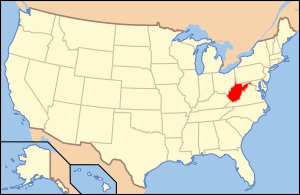Viticulture in West Virginia
| West Virginia | |
|---|---|

|
|
| Official name: | State of West Virginia |
| Appellation type: | State |
| Year of establishment: | 1863 |
| Country: | United States |
| Sub-regions: | Kanawha River Valley AVA , Ohio River Valley AVA , Shenandoah Valley AVA |
| Recognized cultivation area: | 62,792 km² (24,244 sqmi) |
| Grape varieties: | Aurore , Baco Noir , Cabernet Franc , Cabernet Sauvignon , Catawba , Cayuga , Chambourcin , Chancellor , Chardonel , Chardonnay , Concord , DeChaunac , Fredonia , Maréchal Foch , Niagara , Norton , Petite Sirah , Pinot Noir , Riesling , Seyval Blanc , St. Pepin , St. Vincent , Van Buren , Vidal Blanc , Vignoles |
| Number of wineries: | 11 |
Viticulture in West Virginia describes viticulture in the American state of West Virginia . Under US law, every state and county is by definition a protected designation of origin and does not need to be recognized as such by the Bureau of Alcohol, Tobacco, Firearms and Explosives .
The 11 wineries (as of 2008) are divided into 3 designations of origin , which enjoy the status of an American Viticultural Area . Because of the harsh winters, the winegrowers concentrate on growing French hybrid vines . The most important grape variety from the Vitis vinifera family (the so-called European noble grapes ) is the hardy Riesling , which is mainly grown in the northeast of the state.
See also
Individual evidence
- ↑ a b Appellation America (2007). "West Virginia: Appellation Description" . Last page view on October 20, 2008.
literature
- André Dominé (Ed.): Wine . Tandem Verlag, Königswinter 2007, ISBN 978-3-8331-4344-1 .
- Bruce Cass, Jancis Robinson : The Oxford Companion to the Wine of North America . Oxford University Press, Oxford et al. 2000, ISBN 0-19-860114-X .